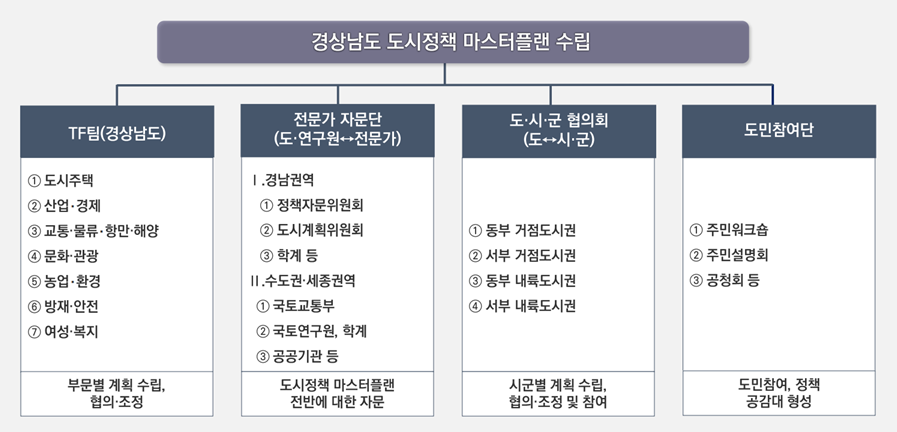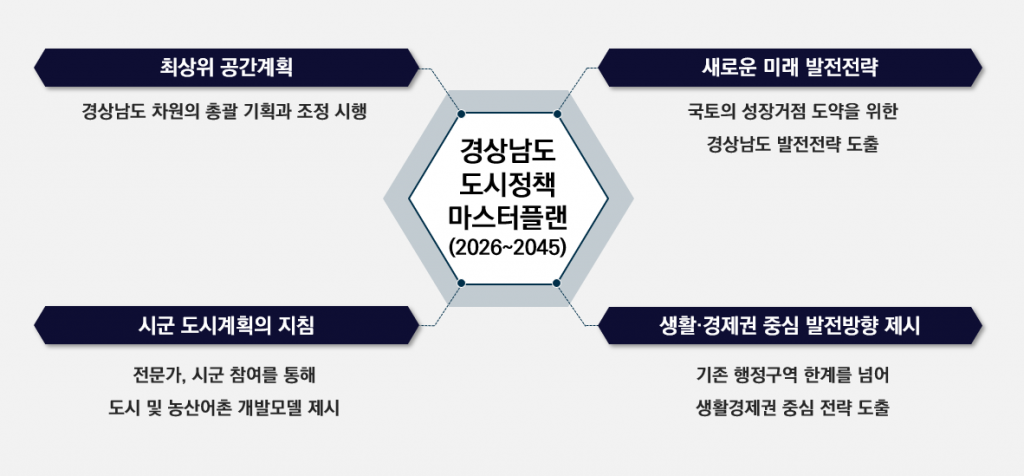The recent widening of the living area, Increased need for joint space planning due to population decline
wide area first, Establishment of unit plan for living economy area based on regional characteristics
Preparing a blueprint for sustainable Gyeongnam through the participation of various actors...Strengthen city competitiveness


◇ Gyeongnam-do, Establishment of future space plans for the entire Gyeongnam area 'start'
As a 20-year mid-to-long-term plan to meet the needs of the times and social and economic changes such as widening the living area, population decline, and low growth, Gyeongnam-do launched the 'Gyeongnam-type Urban Policy Master Plan Establishment' service for the entire area of Gyeongnam-do.
This service, which is promoted by investing 20 billion won in provincial budget, is the top-level spatial plan in the city/county planning system established in a metropolitan province for the first time in the country. It is a comprehensive plan.
◇ a changing society․economic conditions, Need for spatial planning at the Gyeongnam-do level to respond to the needs of the times
The current urban planning system has many problems, such as disharmony in spatial planning due to independent and closed planning establishment and operation by city and county, and distortion of spatial structure due to state-led large-scale development. trend is to
At a time when the provinces may disappear beyond population decline, the problems of various types of cities caused by changes in social and economic conditions require a fundamental change in urban planning, which is established mainly for growth.
In June of last year, Governor-elect Park Wan-soo raised the need for a plan to contain a blueprint for future Gyeongnam to respond to the needs of the times, and the Provincial Governor's Transition Committee proposed the establishment of a master plan for Gyeongsangnam-do's urban policy that made use of the unique characteristics of Gyeongsangnam-do and the establishment of a standing urban planning team dedicated to it.
◇ Responding to new urban changes by establishing spatial planning beyond administrative boundaries
As a spatial plan for the entire Gyeongnam-do, there is a 'provincial comprehensive plan' in accordance with the existing 「Framework Act on National Territory」, but this is at the level of setting the development direction for the entire Gyeongnam-do, and it is difficult to include specific development strategies in spatial units. .
Accordingly, Gyeongsangnam-do plans to include future development strategies and implementation plans for the entire Gyeongsangnam-do as a metropolitan city plan according to the 「National Land Planning and Utilization Act」, which is another spatial plan.
Metropolitan urban planning is the highest plan under the National Territory Planning Act, and is established for the purpose of long-term development, linkage of functions, growth management, and rational arrangement of metropolitan facilities targeting adjacent urban areas in accordance with the widening of the city and the compaction of the city.
* Yeondamhwa: As two or more cities expand, adjacent cities are connected to form one megacity.
With this service, Gyeongnam-do establishes a spatial plan at the Gyeongnam-do level beyond the boundaries of city and county units, prepares a spatial system to actively respond to national policy demands, connects and coordinates plans between the government and cities and counties, and develops cities and rural areas. We plan to present a new urban planning model for
◇ Established as a living economy area plan that reflects regional characteristics such as residents’ life and economy
The Gyeongnam-type urban policy master plan is a concept that expands the concept of the 'living area plan' established in metropolitan cities, and begins with the establishment of a new concept area that considers the living range of citizens such as leisure and shopping and the economic range such as commuting. .
It plans to set up the minimum spatial unit for planning by precisely examining and analyzing the living economy zones in units of eup, myeon, and dong for the entire province, and form a wide-area spatial structure and land use by combining them into a wide-area living economy zone.
By region, ▴industrial/economy placement strategy, ▴culture/tourism linkage strategy, ▴environment/green management strategy, ▴logistics/transport handling strategy, ▴disaster prevention/safety strategy, ▴medical/welfare distribution strategy, ▴agriculture/fishing village specialized strategy, etc. Development strategies for each sector will be prepared, and spatial action plans will be prepared based on them.
In addition, in order to have a guiding character for various national land-related plans established by cities and counties, national land planning evaluations are conducted to secure consistency and connectivity between plans, and in the long term, it will serve as a guideline for balanced development of cities and counties. will be.
An official from Gyeongsangnam-do said, “The plan for living economy zones by region is to promote balanced growth between regions by strengthening the competitiveness and self-sufficiency base for each region. told
◇ Citizen Participation Group, Gyeongnam area and capital‧Participation of various entities such as Sejong area expert advisory group
This plan is established as a plan with the direct participation of Gyeongsangnam-do residents.
Opinions will be collected not only in Gyeongsangnam-do but also nationwide depending on the agenda through the website of the Gyeongnam Provincial Office, rather than simply listening to opinions through a survey or a few meetings.
The first agenda to collect the opinions of the residents is to select the 'name of the plan'. The initially proposed 'Urban Policy Master Plan' has a strong meaning in preparing the overall policy of Gyeongnam-do and has limitations in reflecting the characteristics of Gyeongnam, which has many agricultural, fishing and fishing villages as well as cities. plan to select.
In addition, regional experts in various fields related to Gyeongnam provincial government, such as industry, economy, culture, and tourism, participate in each department, and experts from related organizations such as the Ministry of Land, Infrastructure, and Transport, and the Korea Research Institute for Human Settlements, as well as academia and industry in the field of space planning, participate. They will also participate through an advisory group.
Gyeongnam-do plans to attempt various urban planning transformations through the operation of provincial, city, and county councils together with the 'special team for establishing master plans' composed of all offices, bureaus, and department heads.
Heo Dong-shik, director of the Urban Housing Bureau of Gyeongsangnam-do, said, “Space defines the lives of citizens and influences the future of cities. We will do our best to improve the quality of life of citizens by restructuring urban spaces that have been uniformly established according to the government’s guidelines,” he said. We will focus on strengthening Gyeongnam’s urban competitiveness by converting to a flexible urban planning system that supports



